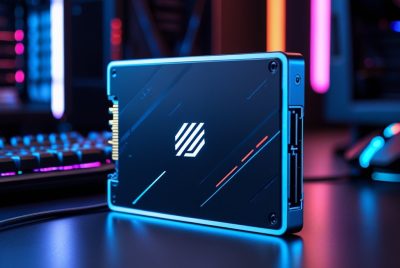Gaming Lights: Enhancing Your Setup for the Ultimate Experience
*We may earn a commission for purchases made using our links. Please see our disclosure to learn more.
Gaming Lights: Enhancing Your Setup for the Ultimate Experience
Gaming lights have become an integral part of any avid gamer’s setup, elevating the immersive experience of the digital worlds I dive into. Their popularity has surged due to their ability to create an ambient mood that enhances focus and complements the in-game visual effects. Utilizing a range of colors and dynamic effects, these lighting solutions serve not only a functional purpose by reducing eye strain but also add a personalized aesthetic to my gaming room.

My exploration into the world of gaming lights has shown me a vast selection of options, suitable for various preferences and room setups. Whether it’s backlighting for a TV or PC monitor, RGB flood lights that envelop the room in color, or smart light panels that I can control with an app or remote, the customization possibilities are endless. Smart compatibility with home devices allows me to synchronize the lighting with game actions or music, further intensifying the gaming experience.
Careful consideration of gaming lights can transform any space into a vibrant gaming environment that reflects my style. From affordable options on Amazon to specialized products from brands like Govee, Nanoleaf, and more, the choices are plentiful. Finding the right fit for my gaming room involves comparing features, prices, and compatibility, all of which can lead to a more engaging and enjoyable gaming setup.
Understanding Gaming Lights

In my exploration of gaming lights, I focus on understanding both their functionality and their ability to transform gaming setups.
Types of Gaming Lights
RGB Lighting: RGB stands for red, green, and blue, the primary colors of light. When mixed together in varying intensities, they can create a wide spectrum of colors. RGB lighting is often a staple in gaming setups due to its customizable color options and effects, which can be synced with gaming actions or music. Products like the Nanoleaf Rhythm Edition, with its rhythm light panels, or the Nanoleaf Lines Smarter Kit, offer dynamic visual experiences.
Smart Lights: These are advanced LED lights that can be controlled via smartphone apps, such as the Govee Home app, or voice assistants. They allow for remote customization of colors and brightness. Smart light bulbs and light bars can be adjusted to match gaming themes or moods. Smart light panels, like Nanoleaf Shapes, can be arranged in unique configurations on walls for a personalized touch.
LED Strips and Lightstrips: LED strips like the Govee Gaming Light Strip G1 are flexible bands of LED lights that can be placed under desks, behind monitors, or around consoles to give a glow that reduces strain on the eyes. These strips sometimes feature integration with platforms like Razer Chroma, allowing for a cohesive lighting response during gameplay.
Wall Panel Lights: These include various shapes that you can assemble on your wall, like a jigsaw puzzle. Each panel emits light and can be individually programmed. The Nanoleaf Canvas Light Panels have a touch-responsive surface, adding another layer of interactivity to your gaming environment.
LED Lights: LED technology is common in game room lighting due to its long lifespan and low energy consumption. Products range from LED light bulbs to more complex LED lightstrips and canvas light panels. These can often be adjusted for brightness and color temperature, optimizing the visual comfort for gaming.
Creating the Perfect Gaming Ambiance

In my experience, the right lighting can significantly enhance the atmosphere of a game room. It’s not just about visibility; it’s about creating an environment that’s both aesthetically pleasing and functionally conducive to an immersive gaming experience. I’ll explore how customization and synchronization contribute to this ambiance.
Lighting Customization and Control
The ability to customize lighting in your gaming space is crucial for setting the desired mood. For colors, blue is often preferred for its cool, calming effect, whereas red can introduce a dynamic, energetic vibe. When it comes to brightness, a flexible system that allows for easy adjustments can cater to the varying visual needs of different games. Dimmable lights are optimal as they can be brightened for clarity or softened to reduce glare and create a warm ambiance.
Customizable features extend beyond color and brightness. Modern gaming lights, such as smart LED strips, enable personalization to suit my aesthetic preferences. Here’s a quick glance at what a customizable setup might include:
| Feature | Description |
|---|---|
| Color Spectrum | A range of colors to choose from, allowing me to pick the perfect hue to echo the game’s mood. |
| Brightness | Adjustable levels, ensuring that the lighting is neither too dim nor excessively bright. |
| Effects | Pre-set or programmable scenes that can match specific games or atmospheres. |
Synchronizing Lights with Gameplay
Synchronizing lights with the action on-screen can create profoundly immersive sights and sounds. Reactive lighting systems that sync with gameplay can elevate my experience, as lights change in response to in-game events. For an even more immersive gaming experience, I can use lightstrips that react to content on my PC monitors, providing a real-time, atmospheric echo to the visuals and sounds of the game.
Here are the key attributes that synchronization features might include:
- Sync with Audio: Lights that change in harmony with the game’s soundtrack or effects.
- Visual Match: The ability to sample colors from what’s displayed on-screen and mirror these colors in the room’s ambient lighting.
- Responsive Patterns: Pre-set or dynamic responses that cause lights to pulse, dim, or change color based on specific in-game actions or events.
By paying attention to both lighting customization and control, as well as how the lights can synchronize with gameplay, I can significantly affect the mood and atmosphere of my gaming space, crafting a truly flexible and aesthetic setup that resonates with my personal style.
Smart Integration and Voice Control

Integrating smart lights into a gaming setup elevates the experience by enabling voice control and seamless interaction with an existing smart home ecosystem.
Compatibility with Smart Home Devices
My gaming room setup features lights that work in harmony with smart home devices. I’ve configured my smart lights to connect with both Google Home and Amazon Alexa, allowing for hands-free operation. Here’s how I’ve integrated them:
- Google Home: Using voice commands through Google Assistant, I can adjust the lighting in my gaming room without having to pause my gameplay. Saying “Hey Google, turn on my gaming lights” or “Hey Google, set the light to blue” activates the lights instantly.
- Amazon Alexa: Alexa works similarly, providing an easy way to change the ambiance. My command, “Alexa, dim my gaming lights to 50%,” is all it takes to adjust the brightness to match my mood or the game’s intensity.
Beyond voice assistants, my lights are controllable via various apps:
- Mobile Apps: With proprietary mobile apps such as the Philips Hue app and third-party apps like SmartLife, I have granular control over color settings, brightness, and even light scheduling, all from the convenience of my phone.
- Music Reactive Features: Some smart lights in my collection are music reactive through both the Philips Hue App and Razer Synapse; this means they respond to the audio from my games or media, creating an immersive gaming atmosphere.
- Apple Home & Matter Compatibility: Apple HomeKit users aren’t left out either. Lights compatible with Apple Home can be integrated for users invested in Apple’s ecosystem. With the emerging smart home connectivity standard, Matter, I look forward to a more unified smart home experience, anticipating that future gaming lights will support both Matter and Thread, enhancing cross-compatibility and ease of use.
By utilizing these integration points, I’ve crafted a gaming space that’s both responsive and interactive, where my voice or a tap on my phone’s screen adjusts the lighting to my exact preferences.
Installation and Maintenance

In setting up gaming lights, I focus on getting the configuration just right and ensuring that the installation process paves the way for a lengthy service life. Here are my hands-on tips for seamless installation and diligent maintenance.
Setting Up Your Gaming Lights
Before I dive into the installation, I make sure I have the correct size and voltage of the lights. Here’s what I typically do:
- Choose the Location: I pick a spot where the lights will have maximum impact on my gaming setup. This could be behind the monitor for bias lighting or around the gaming desk.
- Prepare the Surface: I clean the surface thoroughly to ensure strong adherence for the LED strips. Any home hardware store offers suitable cleaning supplies.
- Measure and Cut: If I’m working with LED strips, I measure the lengths I need and cut according to the manufacturer’s instructions to fit the form factor of my setup.
- Attach the Lights: Using reliable adhesive such as double-sided tape, I attach the LED strips. I prefer LED strips with a strong build quality for a longer lifespan.
- Power and Control: Once in place, I connect the strips to a suitable power supply–checking voltage requirements–and pair them with an LED strip controller for full functionality.
- Check the Configuration: Finally, I check the configuration with the controller, customizing the light effects to my preference.
Note: Always follow the specific installation instructions provided by the manufacturer for a smoother set up process.
Ensuring Longevity
Maintenance is crucial to extending the life of gaming lights:
- Regular Cleaning: I gently wipe the lights using a damp cloth to remove dust and maintain brightness.
- Inspecting for Damage: Routine checks help me spot issues such as loose connections or wear, allowing me to order replacements or make repairs promptly.
- Upgrade Thoughtfully: Innovative lighting options emerge often, so when I consider an upgrade, I ensure compatibility with my existing set up to avoid unnecessary hassles.
By focusing on proper installation and ongoing maintenance, the service life of my gaming lights is maximized, keeping my setup vibrant and dynamic.
Frequently Asked Questions
In my experience, the usage of LED lights in gaming setups is not only about the aesthetics; it’s about the practical enhancements they bring to the gaming experience. I’ll address some specific questions I frequently encounter regarding gaming lights.
1. What are the benefits of using LED lights for gaming setups?
LED lights in gaming setups offer energy efficiency, long lifespan, and a wide range of vibrant colors that can be customized. This flexibility allows me to adjust the ambiance according to my mood or the type of game I’m playing.
2. How do gaming lights enhance the overall gaming experience?
Gaming lights, such as those integrated into keyboards and behind monitors, create an immersive atmosphere. This ambience helps me focus better and feels more immersed in my game world.
3. What features should be considered when choosing the best lighting for a gaming room?
When selecting the best lighting for a gaming room, I consider brightness, color spectrum, and controls for customization. Features like dimmability, color-changing capabilities, and compatibility with gaming systems can significantly impact the gaming mood and environment.
4. Are there specific types of lights that are preferred for desk setups by gamers?
For desk setups, many gamers prefer lights that are directional and minimize glare. Choose LED strips and directional spotlights to prevent screen glare and protect vision for an optimal gaming experience.
5. What makes hexagon lights a popular choice for gaming environments?
Hexagon lights are popular because they offer versatile customization in both color and layout. They can be arranged in unique patterns that complement the gaming setup, adding a creative and personalized touch.




